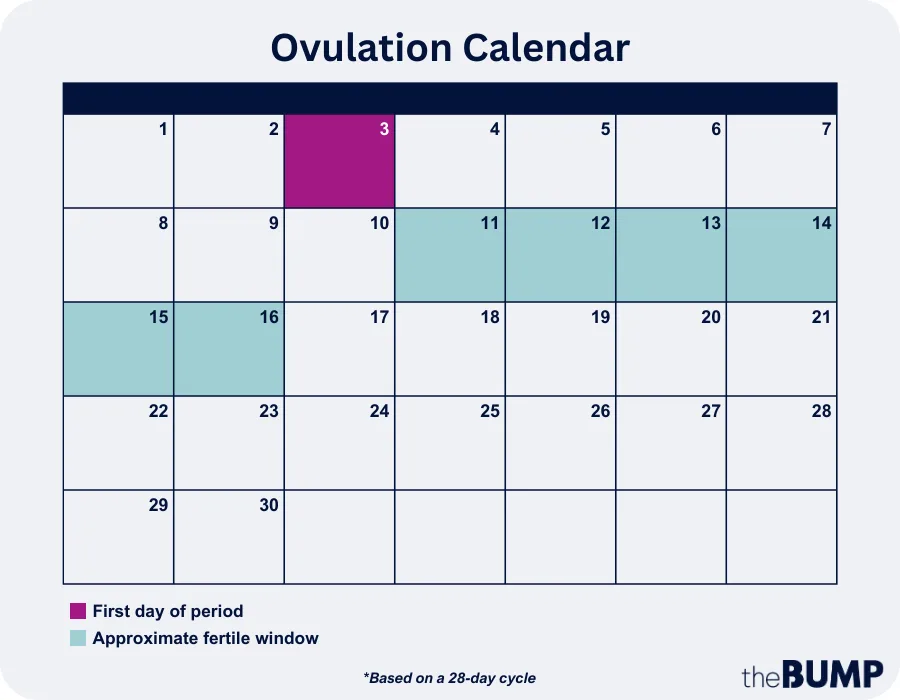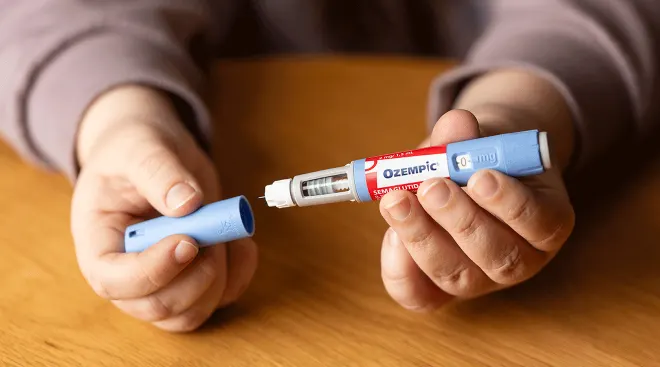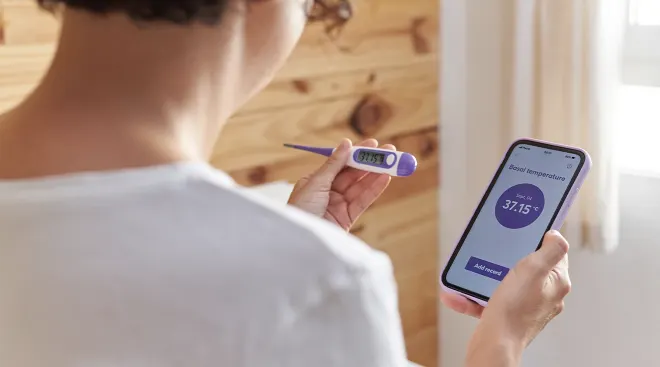Ovulation Symptoms: 9 Signs of Ovulation
If you’re getting ready to grow your family and learning more about conception, you’ll want to get familiar with ovulation. Exactly when you ovulate varies for each woman, but luckily there are ways to recognize the signs of ovulation and time sex accordingly to increase your chances of getting pregnant. Even if you’re not trying to conceive yet, it’s still important to have a good grasp on ovulation signs. Not only can they help you better understand your menstrual cycle, but they can also help you identify any abnormal ovulation symptoms down the road. (In fact, some women keep track of their ovulation patterns as part of their contraception method to avoid getting pregnant.)
Want to learn more about exactly what happens during ovulation? We talked to four ob-gyns to get the lowdown on which signs of ovulation to look out for and how those ovulation symptoms might make you feel. Keep reading for all the expert intel.
Let’s get down to brass tacks: What happens on your ovulation day? You probably learned way back in health class that ovulation is the phase in your menstrual cycle when a mature egg is released from the ovary, setting the stage for fertilization. Every woman is born with millions of immature eggs that wait to be released, normally one at a time, every month. A surge in luteinizing hormone (LH) triggers the release of an egg during ovulation which travels down the fallopian tube, where it may meet up with a sperm and become fertilized. For most healthy women, ovulation generally happens once a month, a few weeks after menstruation begins.
You’re probably wondering, can you feel ovulation happening? It can differ from woman to woman, but there are several common ovulation symptoms you may sense. Before and during ovulation, hormonal shifts can affect the entire body, prompting ovulation symptoms. These can provide powerful but sometimes low-key clues that let you know when you’re ovulating. Many women will experience those ovulation symptoms for up to five days before ovulation as well as the day of, says Patricia Pollio, MD, director of obstetrics at Good Samaritan Hospital in Suffern, New York. They may last for a day after ovulation.
But if you don’t notice any signs you’re ovulating, don’t worry—it doesn’t mean it’s not happening. “Most women have no clue,” says Donnica L. Moore, MD, president of Sapphire Women’s Health Group in Chester, New Jersey. That said, if you can learn to recognize the common signs of ovulation listed below, it could help you predict when ovulation is likely to occur.
Cervical mucus changes
Cervical mucus changes are one ovulation symptom you may experience. As you near ovulation, your body produces more estrogen, causing cervical mucus to become stretchy and clear, like egg white, which helps sperm swim to the egg that’s released during ovulation. Cervical mucus changes happen in most women, Moore says, but you have to know what you’re looking for. The amount of cervical mucus and what it looks and feels like varies from woman to woman. To test it for ovulation, insert a clean finger into your vagina, remove some of the mucus and then stretch out the secretion between your thumb and finger. If it’s sticky and stretchy or very wet and slippery, that’s a good sign you’re in a fertile phase.
Heightened senses
For some women, a more sensitive sense of smell in the latter half of a normal menstruation cycle can be a sign of ovulation. This may be because, in this fertile phase, your body is primed to be more attracted to the male pheromone androstenone. That said, research suggests that ovulation can affect a woman’s overall olfactory perception. Additionally, many women report experiencing a heightened sense of taste.
Breast soreness or tenderness
Tender breasts or sore nipples can be another sign of ovulation, thanks to the rush of hormones entering your body right before and after ovulation. Some women will experience this tenderness just before ovulation, while others may feel it right after ovulation occurs. Of course, breast tenderness can also occur at other times in the menstrual cycle, notes Jenna Turocy, MD, an ob-gyn and reproductive endocrinologist with Columbia University Irving Medical Center in New York City. “It’s typically linked to hormonal changes not directly related to ovulation.”
Mild pelvic or lower abdominal pain
A lot of women wonder, can you feel ovulation? And for some, the answer is actually yes—typically as a mild ache or pain in the lower abdomen, usually on one side or the other (not the same side each time). So what are ovulation pains like? Called Mittelschmerz, ovulation pain can feel like a sharp or dull cramp on the side of your abdomen where the ovary is releasing the egg. This ovulation side effect can last anywhere between a few minutes and a few hours. You might also experience light vaginal bleeding, discharge or nausea along with the ache or pain, which is usually mild and short lived.
There’s no need to worry about ovulation pain that goes away with an OTC, anti-inflammatory medication (such as Motrin), Moore says. But if ovulation pain is persistent or severe, see a doctor to rule out conditions such as endometriosis or an ovarian cyst. Moore suggests monitoring and recording your ovulation symptoms every month to get a sense of what is normal for your body, so you can more easily spot any abnormal ovulation signs and symptoms. “When in doubt, check it out,” she adds.
Many women wonder whether ovulation pain is a sign of fertility. It can be, since it indicates that an egg is being released (although there’s no guarantee it’ll be fertilized that cycle.) But you can still be fertile without feeling any pain, so it’s best not to rely on this ovulation side effect as a way of assessing your fertility.
Light spotting or discharge
“Ovulation can sometimes cause a small amount of spotting or brown discharge due to the surge in hormones,” says Turocy. This ovulation symptom can occur when the follicle that surrounds and protects the developing oocyte (the egg) matures, grows and then ruptures, resulting in a small amount of bleeding. As blood gets older, it turns brown, which is why the ovulation discharge may range from red to dark brown. It’s not a cause for concern unless the spotting persists, in which case you should see a physician to check for signs of infection and the possibility of an ectopic pregnancy if you’ve been sexually active.
Libido changes
A change in libido is another common ovulation symptom. Some women notice that their sex drive increases during ovulation, which might be Mother Nature’s way of encouraging procreation. Interestingly, research suggests that women in relationships are more likely to experience a boost in libido during ovulation versus single women. But, as Moore says, “sex drive can be influenced by just about anything, including whether you had a glass of wine or are just in the mood.”
Changes in the cervix
During ovulation, your cervix may become higher, softer and more open. You can check your cervix, along with your mucus, for ovulation symptoms, but it can take time to learn the differences you’re feeling for and is often more difficult than watching for the other signs of ovulation mentioned above.
If you’d like to try and get more comfortable checking for cervical changes as a sign of ovulation, Moore recommends standing in whatever position you use to insert a tampon (for example, next to the toilet with one foot up on the closed seat) and using your finger to feel inside. In many women with a regular cycle, right before ovulation the cervix will be softer, like touching your lips, but after ovulation it will feel harder, more like touching the tip of your nose. An OB can also check for cervical changes using a speculum and help give you more guidance on how to do it at home.
Nausea and headaches
Many women ask: Can ovulation make you feel sick? The answer is yes. Nausea and headaches are two possible ovulation side effects due to the change in your estrogen and progesterone levels. That said, these aren’t generally considered common or severe symptoms, says Turocy. “If you’re experiencing severe symptoms, it’s important to consult a provider to rule out other underlying issues,” she adds. Moreover, you may be more likely to experience headaches during ovulation if you’re prone to them: A study found that about half of women of childbearing age with recurring migraines experience them during ovulation.
Changes in your basal body temperature
Sometimes referred to as BBT, your basal body temperature is the temperature of your body at rest. At the beginning of your cycle, basal body temperature remains fairly consistent and averages between 97 to 98 degrees Fahrenheit; as you get closer to ovulation, you’ll experience a slight dip in basal body temperature followed by a sharp increase, typically of about 0.4 to 1.0 degrees, just after ovulation, notes the Cleveland Clinic. While you may not actually feel this symptom, it can still be a sign of ovulation. Your basal body temperature will rise during ovulation and stay elevated during that time. After tracking your basal body temperature for a few months, you’ll begin to more readily notice the patterns and identify notable changes.
Now that we’ve reviewed ovulation symptoms, you may still be wondering exactly when ovulation occurs. You may have heard that ovulation typically happens on day 14 of a 28-day menstrual cycle, but it’s not the same for everyone.
If you’re like most women of childbearing age, your menstrual cycle lasts between 28 and 32 days, and ovulation usually hits between days 10 and 19 of that cycle—about 12 to 16 days before your next period. “In healthy women, ovulation occurs 14 days before the onset of your period,” says Moore. So if your cycle is 35 days, ovulation will happen on day 21 of that cycle—but if your cycle is 21 days, ovulation will happen on day seven.
The timing of ovulation can vary from cycle to cycle and from person to person, adds Shannon M. Clark, MD, associate professor at the University of Texas Medical Branch at Galveston in Texas. This is why it’s a good idea to get familiar with your body’s menstrual calendar for at least three months or so, to help you better estimate your own ovulation cycle.
For some women, ovulation doesn’t always take place, or it can be irregular. In general, if you’re pregnant, have gone through menopause or you take birth control pills consistently and on time, you won’t ovulate. Certain diseases or disorders, such as polycystic ovary syndrome or premature ovarian failure, among other conditions, can also cause anovulation (a lack of ovulatory function), according to the Cleveland Clinic. Medications, including some antidepressants, anti-nausea medications and chemotherapy, may also cause a woman to stop ovulating for periods of time. Other lifestyle factors—such as chronic stress or being significantly underweight or overweight (measured by body fat percentage)—may affect female fertility and ovulatory function as well.
If you’re dealing with irregular menstrual cycles or ones that are particularly short (fewer than 21 days) or long (more than 35 days), consider getting evaluated by a physician to rule out any medical conditions. “It’s essential to identify the underlying cause of irregular ovulation and work with a fertility expert to address it if you’re looking to [conceive] a baby,” advises Turocy.
It’s true that tracking ovulation with irregular cycles can be more difficult, but keep in mind that ovulation occurs 14 days before the onset of menstruation, so even with irregular periods, you could still conceive at some point in your cycle.
If you’re planning to breastfeed exclusively (meaning baby won’t get any other source of nutrition), be aware that you likely won’t ovulate during that time. But there are always exceptions, so you can’t depend on breastfeeding as a method of birth control, as ovulation can precede your first postpartum period, according to a report in Clinics in Perinatology. Of course, once baby is introduced to other foods or the occasional bottle, ovulation is likely to resume. Plan your birth control accordingly, unless you want to give baby the possible surprise of a new brother or sister!
How long does ovulation last?
So you’re probably wondering, for how many days do women ovulate? “Ovulation itself (the actual releasing of the egg from the ovary) is a relatively short event,” says Turocy. Once the mature egg is released from the surface of the ovary, it can potentially be fertilized for about 24 hours, adds Pollio.
That said, you don’t have to have sex on the exact day of ovulation in order to get pregnant. In reality, there’s a six-day “fertile window” in your cycle—the five days leading up to ovulation and the day you ovulate, Moore says. Of those six days, you’re most fertile during the two to three days prior to ovulation and the day of ovulation itself.
Beyond 24 hours after ovulation, the egg is no longer viable and you typically can’t get pregnant until your next menstrual cycle, notes the National Library of Medicine. (If you’re not trying to conceive, though, you should still use birth control at all times as a precaution.)
Whether you’re trying to conceive or merely want to get to know your body’s signs of ovulation, these indicators, including at-home and over-the-counter (OTC) tests, can help you learn how to tell if you’re ovulating (or are about to).
Basal body temperature monitoring
One way to know if you’re ovulating is to track your basal body temperature over a series of months. Take your temperature with a digital thermometer designed for basal body as soon as you wake up—even before you get out of bed—and jot down the reading every morning. Keep in mind that from day to day, your BBT can fluctuate by half a degree or more, so don’t be fooled by a little blip—look for a sustained rise to confirm that you’ve ovulated. After several months the info will give you a good sense of when you usually ovulate so you can plan babymaking accordingly.
Menstrual charting
Another simple and inexpensive way to track ovulation is to record the days your period begins and ends for several months. If you have normal menstrual cycles—between 25 and 35 days—you’re likely to be ovulating regularly, with ovulation occurring about 14 days before menstruation. Make sure to write down whenever you experience potential signs of ovulation: Remember, typical ovulation symptoms may include cramps, an increase in cervical mucus, breast tenderness, fluid retention and appetite or mood changes.
Ovulation kit
OTC ovulation predictor kits measure your levels of luteinizing hormone (LH), which can be detected in your urine. These kits work because ovulation typically hits about 10 to 12 hours after LH peaks—on day 14 to 15 of the menstrual cycle if your cycle is 28 days long. Your LH concentration should stay elevated for 14 to 27 hours to allow for full maturation of the egg.
Here’s how the ovulation kit works: Pee on the stick and wait for a line to appear. If the color of the line matches the shade shown on the instructions, ovulation is imminent—within 24 to 48 hours. If it’s too close to call, retest within the next 12 hours. Most kits come with a five-day supply of sticks, to be used in as many days, but check their expiration date: Most of them have a shelf life of only two years. While the majority of ovulation predictor tests can be used any time of day, many of them suggest testing first thing in the morning. For best results, test around the same time each day, and cut back your liquid intake for four hours beforehand, so your pee will be more concentrated and your LH easier to detect.
The real trick to finding success with an ovulation predictor kit is knowing when to start using it. If your cycle is regular, the charting you’ve been doing can help you identify that optimum window. If your cycles are irregular, your best bet is to pay attention to ovulation symptoms.
Fertility monitor
While an ovulation predictor kit can identify when ovulation is expected to occur (giving you 24 hours for possible conception), a fertility monitor can identify your five most fertile days. The monitor measures LH and estrogen levels to identify your two peak fertile days, plus the one to five fertile days leading up to them. Some versions of the monitor store information from your previous six cycles to customize your fertility reading. Be aware, though, that because monitors give you more advanced information, they’re pricier than ovulation kits.
Understanding when you ovulate is key to getting pregnant, but it can also give you clues about why you’re suddenly experiencing certain symptoms. When you know the signs of ovulation, you can be better prepared, regardless of whether or not you’re trying to conceive. The more in tune you are with your body, the better you’ll be able to predict when ovulation will occur.
Frequently Asked Questions
What does ovulation feel like?
Still wondering if you can feel when you ovulate? The answer is a resounding maybe. Ovulation symptoms can be different from person to person–or they may not be noticeable at all. “Some women experience mild discomfort or a twinge in their lower abdomen around the time of ovulation. However, not all women feel ovulation, and the sensation, if present, is typically subtle,” says Turocy. Of course, tracking any physical changes you feel throughout your monthly cycle may eventually help you better identify recurring signs of ovulation versus otherwise occurring aches, pains and discomforts.
Does a lack of ovulation symptoms mean you’re less fertile?
Many women experience no noticeable ovulation symptoms, confirms Turocy. A lack of symptoms doesn’t have a direct impact on fertility. Women can still be fertile without experiencing overt signs of ovulation. In the same vein, “the presence and intensity of ovulation symptoms” doesn’t necessarily correlate with higher levels of fertility, Turocy says. “The most reliable way to monitor for ovulation is through using ovulation predictor kits, identifying changes in cervical mucus and monitoring hormone levels in your bloodwork,” she adds.
Can you get pregnant if you don’t ovulate?
“Ovulation is a prerequisite for natural, unassisted conception,” says Turocy. Suffice it to say that if you're not ovulating at all, you can’t get pregnant without medical intervention. However, some women may still release an egg irregularly and get pregnant even if they don't ovulate regularly.
Can ovulation affect your mood?
You’re probably already familiar with the mood changes that happen right before your period appears (hello, PMS!). But it turns out, that’s not the only time of month your spirit, humor and state of mind may shift: Research has indicated that many women report a positive effect on their mood (let’s call it a happy boost!) during ovulation.
Why do I feel bloated around ovulation time?
Looking a little swollen as of late? It may be that time of the month (or, you know, the other time of the month!). A study found that some women report feeling more bloated in the days leading up to ovulation through menstruation. Of course, given the extended duration of this symptom, it might be a bit difficult to pinpoint exactly where you are in your cycle based on bloat alone.
Why do I crave meat close to ovulation time?
Suddenly hankering for meat and bread? You might be ovulating. A study found that women tend to take in more carbohydrates, proteins, fibers and calcium during ovulation. On the other hand, if you’re craving sweets, salt and fatty foods, you may be closer to menstruation.
Please note: The Bump and the materials and information it contains are not intended to, and do not constitute, medical or other health advice or diagnosis and should not be used as such. You should always consult with a qualified physician or health professional about your specific circumstances.
Plus, more from The Bump:
Donnica L. Moore, MD, is a women's health expert and advocate, as well as president of Sapphire Women’s Health Group in Chester, New Jersey. She has been a women's health contributor for NBC's Later Today and guest on NBC's Weekend Today Show, The Oprah Winfrey Show, The View, Good Morning America and CNN-International.* She received her medical degree from the State University of New York at Buffalo School of Medicine.
Shannon M. Clark, MD, MMS, is an OB-GYN and maternal fetal medicine specialist, as well as an associate professor at the University of Texas Medical Branch at Galveston in Galveston, Texas. She earned her medical degree from the University of Louisville School of Medicine, in Louisville, Kentucky, and completed her residency at Allegheny General Hospital in Pittsburgh, Pennsylvania.
Patricia Pollio, MD, is the director of OB-GYN at Good Samaritan Hospital in Suffern, New York. She received her medical degree from Joan Sanford I Weill Medical College oOf Cornell University in 1989 and has been in practice for more than 30 years.
Jenna Turocy, MD, is an ob-gyn and reproductive endocrinologist with Columbia University Irving Medical Center in New York City. She earned her medical degree from Georgetown University School of Medicine.
StatPearls, Physiology, Ovulation, May 2023
Japanese Journal of Physiology, Human Olfactory Contrast Changes During the Menstrual Cycle
The Journal of Sex Research, Ovulatory shifts in female sexual desire, February 2024
Frontiers in Neurology, Cerebrovascular Function in Hormonal Migraine: An Exploratory Study, July 2021
Obstetrics and Gynecology International, Fluid Retention over the Menstrual Cycle: 1-Year Data from the Prospective Ovulation Cohort, August 2011
RBGO Gynecology & Obstetrics, Do Food Intake and Food Cravings Change during the Menstrual Cycle of Young Women?, November 2018
Cleveland Clinic, Basal Body Temperature, December 2022
Frontiers in Global Women's Health, Chronic Stress and Ovulatory Dysfunction: Implications in Times of COVID-19, May 2022
Metabolism, The effect of underweight on female and male reproduction, June 2020
Reproductive Biology and Endocrinology, Obesity as disruptor of the female fertility, March 2018
Heliyon, Comparison of affect changes during the ovulatory phase in women with and without hormonal contraceptives, April 2017
Clinics in Perinatology, The effect of lactation on ovulation and fertility, March 1987
Medline Plus, National Library of Medicine, Pregnancy: Identifying Fertile Days, January 2022
Learn how we ensure the accuracy of our content through our editorial and medical review process.
Navigate forward to interact with the calendar and select a date. Press the question mark key to get the keyboard shortcuts for changing dates.





















































